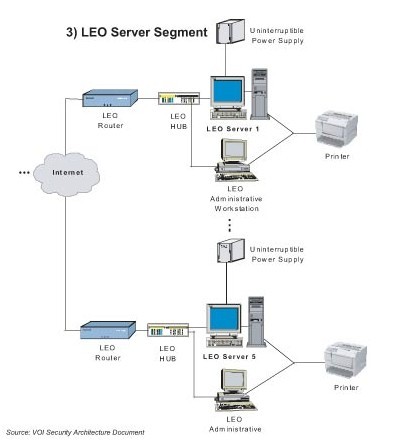
Voting Over the Internet
USINFO | 2013-09-05 11:26

FVAP designed the system to mimic established absentee ballots. They did not design the system to tabulate votes. Each volunteer received a CD that had a browser plug-in designed to display and transmit ballots to the FVAP servers. The system required that volunteers use Netscape Navigator 4.05 or higher with strong encryption. The Department of Defense (DOD) oversaw a digital certification program to authenticate voter identity. Once a voter transmitted a ballot, the DOD would deactivate his certification to prevent him from voting again.
Encrypted ballots were transmitted over the Internet to the FVAP server. Only the intended destination of the ballot remained unencrypted. The server was in a secure location with very limited access and an uninterrupted power supply. Two intrusion detection systems were installed to monitor any attempts at fraudulent activity.
Local Election Officials (LEOs) used terminals at their local sites to access an LEO server. This server connected to the FVAP server, which transmitted the encrypted ballots addressed to that LEO site over the Internet. Once the ballots arrived, a computer at the LEO site decrypted them and printers produced paper copies. LEO volunteers transcribed the printed results onto paper-based absentee ballots.

. . . the FVAP Server, which sends encrypted ballots to . . .

. . . the proper Local Election Officials' servers for tabulation.
At the conclusion of the experiment, FVAP officials declared the pilot program a success. They concluded that remote voting on a small scale with tight controls was an acceptable alternative to casting a traditional absentee ballot. They also noted that this was an experiment involving less than 100 participants; implementing a system to allow thousands or millions of citizens to vote using the Internet would require more thought.
The Secure Electronic Registration and Voting Experiment
After the success of VOI, Congress requested that the DOD conduct a larger Internet-based voting program. In 2001 the DOD began to design the Secure Electronic Registration and Voting Experiment (SERVE). The DOD estimated that 100,000 citizens would participate in the experiment, and their votes would be counted in both the primaries and the general election of 2004. If the experiment were deemed a success, Internet voting would be extended to all overseas military personnel and other citizens.
In early 2004, the DOD canceled the experiment due to concerns about security issues, ending the program before the implementation phase. Specific concerns included voter anonymity being compromised or hackers intercepting and manipulating ballots sent over the Internet. Congress has requested the DOD to try the experiment again once the Election Assistance Commission (established by HAVA) creates new guidelines for absentee voting and registration in 2007.
The VOI and SERVE programs were both designed to provide greater accessibility to voters who are overseas or otherwise must cast absentee ballots. Such voters number in the hundreds of thousands, and yet this population makes up only a small percentage of the overall number of registered voters. Internet-based votes will have to satisfy skeptics with secure, reliable and repeatable instances of voter verification, ballot display, ballot recording and ballot transmission. It may be many years before we see the Internet used as a significant voting system in the United States.
Share this page



















